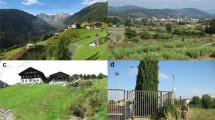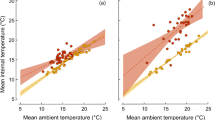Abstract
Paper nests of social wasps are intriguing constructions for both, biologists and engineers. We demonstrate that moisture and latent heat significantly influence the thermal performance of the nest construction. Two colonies of the hornet Vespa crabro were investigated in order to clarify the relation of the temperature and the moisture regime inside the nest. Next to fairly stable nest temperatures the hornets maintain a high relative humidity inside the nest. We found that in consequence a partial vapor-pressure gradient between nest and ambient drives a constant vapor flux through the envelope. The vapor flux is limited by the diffusion resistance of the envelope. The driving force of vapor flux is heat, which is consumed through evaporation inside the nest. The colony has to compensate this loss with metabolic heat production in order to maintain a stable nest temperature. However, humidity fluctuations inside the nest induce circadian adsorption and desorption cycles, which stabilize the nest temperature and thus contribute significantly to temperature homeostasis. Our study demonstrates that both mechanisms influence nest thermoregulation and need to be considered to understand the thermodynamic behavior of nests of wasps and social insects in general.



Similar content being viewed by others
References
Chown SL (2002) Respiratory water loss in insects. Comp Biochem Physiol A-Mol Integr Physiol 133:791–804
Dascalaki E, Santamouris M, Balaras CA, Asimakopoulos DN (1994) Natural convection heat transfer coefficients from vertical and horizontal surfaces for building applications. Energy Build 20:243–249
Gibo DL, Dew HE, Hajduk AS (1974a) Thermoregulation in Colonies of Vespula arenaria and Vespula maculata (Hymenoptera-Vespidae). 2. Relation between Colony Biomass and Calorie Production. Can Entomol 106:873–879
Gibo DL, Yarascavitch RM, Dew HE (1974b) Thermoregulation in colonies of Vespula arenaria and Vespula maculata (Hymenoptera-Vespidae) under normal conditions and under cold stress. Can Entomol 106:503–507
Hagentoft C-E (2001) Introduction to Building Physics. Studentlitteratur, Lund
Hansell MH (1996) Wasps make nests: Nest make conditions. In: Turillazzi S, West-Eberhard MJ (eds) Natural history and evolution of paper-wasps. Oxford University Press, Oxford, pp 272–289
Heinrich B (1993) The hot-blooded insects: Strategies and mechanisms of thermoregulation. Springer, Berlin
Himmer A (1932) Die Temperaturverhältnisse bei den sozialen Hymenopteren. Biol Rev 7:224–253
Ishay J (1973) Thermoregulation by social wasps: Behavior and pheromones. Transactions New York Academy of Sciences 35:447–462
Ishay JS, Barenholz-Paniry V (1995) Thermoelectric effect in Hornet (Vespa orientalis) silk and thermoregulation in a hornets nest. J Insect Physiol 41:753–759
Ishay JS, Shmuelson M (1996) Thermoelectric properties of the hornet comb: A device for producing, transforming and storing electrical energy for the entire colony. Physiol Chem Phys Med NMR 28:41–54
ISO (2001) EN ISO 12572-Hygrothermal performance of building materials and products-determination of water vapour transmission properties. CEN
Prange HD (1996) Evaporative cooling in insects. J Insect Physiol 42:493–499
Riabinin K, Kozhevnikov M, Ishay JS (2004) Ventilating activity at the hornet nest entrance. J Ethol 22:49–53
Schmolz E, Brüders N, Daum R, Lamprecht I (2000) Thermoanalytical investigations on paper covers of social wasps. Thermochim Acta 361:121–129
Schmolz E, Lamprecht I (2004) Thermal investigations on social insects. In: Lörinczy D (ed) The nature of biological systems as revealed by thermal methods. Kluwer Academic Publishers, Dordrecht, pp 251–283
Turner JS (2000) The extended organism. The physiology of animal-built structures. Harvard University Press, Cambridge, MA
Acknowledgement
We thank K. Weiss and R. Vonbank for their support in constructing the experimental setup. This work was supported by the Swiss National Science Foundation (SNF, Nr. 205321-103547). The experiments performed comply with the current laws of Switzerland.
Author information
Authors and Affiliations
Corresponding author
Rights and permissions
About this article
Cite this article
Klingner, R., Richter, K., Schmolz, E. et al. The role of moisture in the nest thermoregulation of social wasps. Naturwissenschaften 92, 427–430 (2005). https://doi.org/10.1007/s00114-005-0012-y
Received:
Accepted:
Published:
Issue Date:
DOI: https://doi.org/10.1007/s00114-005-0012-y




